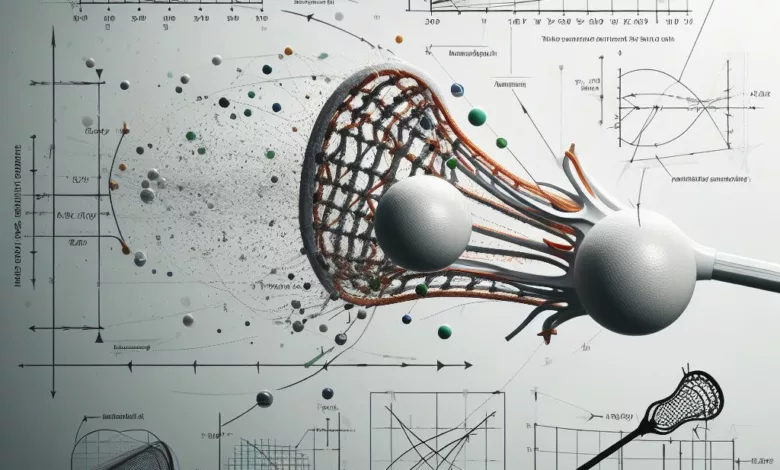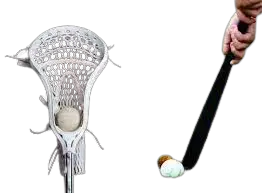From Stick to Net: Understanding Lacrosse Ball Travel Speed

If you want to know how fast does a lacrosse ball travel then,
You would already be aware that lacrosse is a very fast-paced activity that necessitates quick maneuvers and reactions if you had merely observed it from a distance. Of course, you can only truly appreciate how quick this game is by actually playing it. The speed at which the lacrosse ball goes is what makes this game so frantic. But how quickly does racquetball move?
The finest amateurs and professionals in lacrosse throw the ball between 90 and 105 miles per hour on average. Naturally, the figure is smaller for amateurs at lower skill levels. The fastest lacrosse toss ever observed clocked in at above 123 mph.
How fast lacrosse ball travel?
Having said that, lacrosse balls can move very quickly. Even still, shots traveling at speeds above 100 mph are often only made by professional lacrosse players; lesser speeds are more typical among regular lacrosse players. Please follow along with me as I go through everything to understand more about the lacrosse throw speed ranges and what influences them.
We need to look more closely at the facts and data to fully comprehend the changes between various levels of play and the range of lacrosse throws and balls' speeds. Check out the table below on how to do this. As you can see, the top lacrosse shooters at lower levels are capable of throwing shots that are more potent than those of lower levels. Also, keep in mind that these are just averages and that actual speeds may vary from these ranges in either direction.
You should keep in mind that the stats presented above were obtained from shooting tests conducted during lacrosse practice and do not represent actual game statistics. Since there are currently no tools available to track every lacrosse shot taken throughout a game, it would be incredibly challenging, if not impossible. As a result, the shots are acquired utilizing devices like a shooter radar or a velocity speed gun. Let's now examine more closely how a player's lacrosse shot speed is impacted.
What factors affect the speed of lacrosse?
You would be gravely misled to believe that generating a quick lacrosse shot is merely a matter of point-and-shoot. The throw speed in lacrosse is influenced by a variety of factors. Let's take a closer look to completely comprehend what's behind the most effective and unsuccessful shots.
Player strength:
Power comes from strength, and speed comes from speed. Therefore, a lacrosse player has a better probability of throwing a shot that is more powerful and faster the stronger they are. Of course, technique is crucial in this, and even strong technique isn't very useful without it. In reality, a player who has perfected their throwing technique will be able to throw the ball farther and faster than a player who is merely physically strong. However, one of the key factors affecting a lacrosse ball's speed is a player's strength.
Player age:
Strength and age are frequently correlated, but not always. However, it's a really good technique to anticipate and estimate how quickly a lacrosse player from different age groups would throw. Lacrosse is often played between the ages of 8 and 13, in high school between 14 and 18, and in college between 18 and 19. As various people begin their college careers at different ages, additional ages do exist. Although the majority are college graduates and beyond, professional lacrosse can start at the age of 18 or above. As you might expect, player strength and level of play correlate with age, which has a significant impact on the speed of a lacrosse throw.
Throwing technique:
The technique is most likely the most crucial element in a lacrosse shot's speed. The following are examples of good throwing technique practices: Rotation of the body: The torso and body provide the real power. A full range of body movement will therefore result in the shot having higher speed and power. A rigid body rotation with no movement won't ever be able to transfer enough speed.
Wrist action: By snapping your wrist at the very end of the throwing motion, you may force the ball out of the mesh pocket much more quickly and produce a more potent shot. Snapping your wrist can also increase accuracy in addition to velocity. Whip: A high whip throw has a longer time in the mesh bag during the throwing motion, which results in a stronger shot. With a low whip, the ball leaves the stick earlier and moves at a lesser speed.
The last stage of a lacrosse shot's speed optimization is the follow-through. To transfer all of the energy and power onto the ball, the hips, arms, and entire act must move to the exact limit of their range of motion.
As you can see, there are a lot of places in the technique that need to be improved to produce a shot with a lot of power. Body rotation is the most crucial element of the lacrosse throw technique.
Stick length:
You may already be aware that lacrosse uses short, long, and goalie sticks. The sizes of their heads and sticks differ. What then is the lacrosse stick with the most power?
Shorter sticks typically provide for easier control and the transmission of more power to the ball. One player would use a short stick and the other a long stick if two players with identical physical and skill attributes were to throw a ball. In this scenario, the shooter with the short stick would fire more quickly.
The ball might not, however, fly any further as a result of this. In lacrosse, offensive players wear it since it would only have a faster initial speed. Lacrosse sticks, however, go by a variety of names. You should research them to see if you can discover any new ones or identify any classics.
What is the world’s fastest lacrosse shot?
The statistics for the fastest lacrosse shots ever differ significantly from those of the ordinary player. The best players are on a completely other level, which is pretty much true in every aspect of life. What is the quickest lacrosse shot in the world?
The fastest lacrosse shot was thrown by Ohio State Buckeyes player Nick Diegel in 2020 at a speed of 127.4 mph (205 kph). You should keep in mind that there are too many distractions and variables present in real play for the throws to happen this quickly. Nick Diegel launched this magnificent shot at a velocity radar. However, a lacrosse shot traveling at 127 mph is astounding, and I doubt anyone will ever surpass that.
What is the world’s longest lacrosse throw?
There are distinct numbers because speed and length are two different concepts. Because the defense is unlikely to intercept a really strong short shot, the offense is put in a fantastic position to score. What is the record for the longest lacrosse toss, then? The longest lacrosse shot ever was launched by Barnett Quinn of Ottawa, Canada, in 1892, and it measured 162.86 yards (148.91 meters), according to Guinness World Records. Since it occurred so long ago, there isn't much information available, but Guinness World Records is a reliable source that I think we can all rely on. That's an impressive throw, especially in light of the stats. I want to see where you can throw a lacrosse ball as far as you can.
Conclusion:
In the dynamic world of lacrosse, understanding the speed of a lacrosse ball is not just a matter of statistics but a testament to the game's intensity and skill. Through this exploration, we've uncovered the incredible speeds that professional lacrosse players can achieve, often exceeding 100 miles per hour. This velocity is not just a result of physical prowess but also the culmination of years of practice, dedication, and strategic gameplay.
The speed of a lacrosse ball is more than just a number; it represents the synergy between player and equipment, the finesse of technique, and the thrill of competition. Whether you're a player striving to perfect your shot, a coach aiming to enhance your team's performance, or a fan marveling at the athleticism on the field, appreciating the speed of a lacrosse ball adds depth to your passion for the sport.
As technology advances and players continue to push their limits, we can only anticipate that the speeds reached by lacrosse balls will keep astounding us, making every game a spectacle of skill and velocity. So, the next time you watch a lacrosse match, remember, that behind every fast-flying ball, there's a story of dedication and the pursuit of excellence.
FAQs:
Q1: How fast can professional lacrosse players shoot the ball?
A1: Professional lacrosse players can shoot the ball at speeds exceeding 100 miles per hour. This incredible velocity is achieved through a combination of physical strength, proper technique, and years of training.
Q2: What role does player technique play in the speed of the lacrosse ball?
A2: Player technique is paramount in determining the speed of a lacrosse ball. Proper body positioning, wrist snap, and follow-through significantly impact the velocity and accuracy of the shot. Players spend countless hours honing these skills to deliver powerful and precise shots.
Q3: Can the type of lacrosse stick affect the ball's speed?
A3: Yes, the type of lacrosse stick, including the head design, string tension, and pocket placement, can influence the ball's speed. Players often customize their sticks to match their playing style, optimizing their shots for speed and accuracy.
Q4: Are there any safety concerns related to high-speed lacrosse shots?
A4: Yes, high-speed lacrosse shots can pose safety concerns, especially if players are not properly protected. That's why lacrosse players wear extensive protective gear, including helmets, gloves, and padding, to minimize the risk of injuries when facing fast shots.
Q5: How can aspiring lacrosse players improve their shot speed?
A5: Aspiring lacrosse players can improve their shot speed through consistent practice, strength training, and working closely with experienced coaches. Developing proper shooting mechanics and enhancing overall physical strength can lead to significant improvements in shot speed over time.




